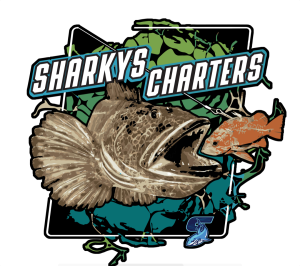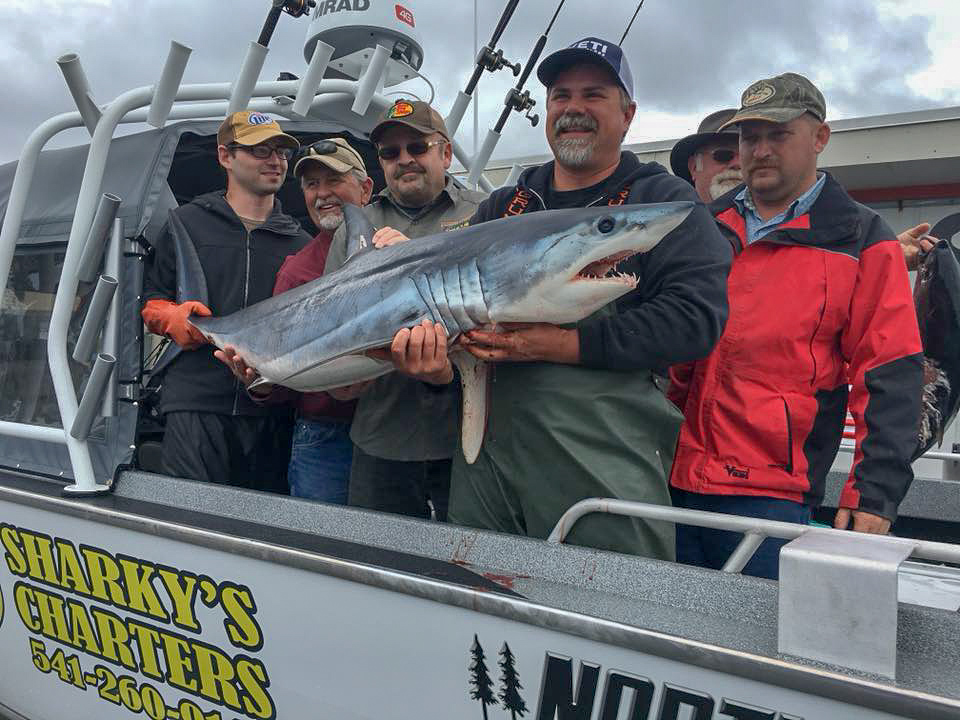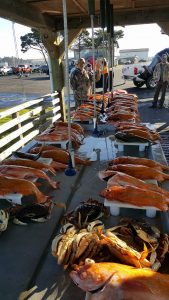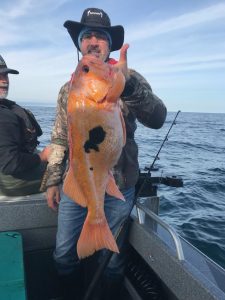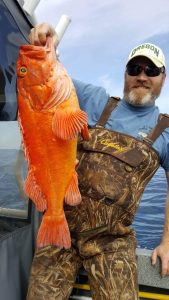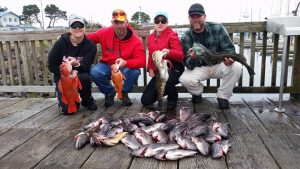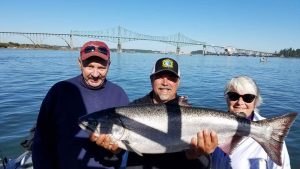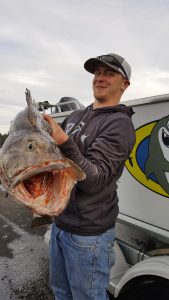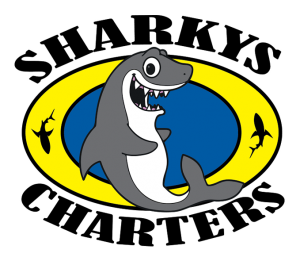It was August of 1979, and my grandparents Bob and Barbra Paquotte had returned to their annual salmon camp at Riverbend near Newport, Oregon. My grandfather loved boating, and it was an escape from the summer heat in the valley. They had been coming to the coast every summer since they were married in 1956 to fish and vacation with my grandmother’s brothers Jack and George Scott of Waterloo, Oregon. Jack and George had a boat called the “Waterloo Shark”, this could be where I got the idea for Sharky’s Charters?!. This was a special trip because they had brought me along. I was just four years old and they had a new boat the “Barbie Doll”, a 1973 21’ Rienell that later I would get as a graduation present in my 20’s. You might think that’s awfully young to be taking a kid out fishing on the ocean but reportedly I was a good kid and my grandparents were very patient. We stayed in their small RV that night, me on the top bunk and my grandparents below me. I was the first awake the next morning, and I remember laying there listening for my grandparents to stir. Not hearing anyone and being four I called out to my grandfather, “Poppy is it time to go fishing yet?”. I remember he answered back to me, and I rolled off the bunk and into his arms. This moment, I believe, was the start of my fishing career and love for the ocean. In 1979, Coho and Chinook salmon were plentiful off the Oregon coast. According to Oregon Department of Fish and Wildlife records almost 175,000 Coho and 200,000 Chinook were landed that year from Oregon ports by the recreational fisherman who made nearly 300,000 angler trips. There would be so many recreational boats out trolling for salmon one would just join the fleet and catching was easy. The marinas were full of recreational boats and the ports economy was alive with salmon fisherman. A stark reality exists today in the salmon fishery that was unimaginable in 1979. In 2017 only 21,222 Coho and, 4,594 Chinooks were caught by recreational fisherman. I grew up with summers on the docks in Newport and out salmon fishing with my grandparents, and to me salmon fishing is my heritage. The ocean was in my blood for good. It wasn’t until 1993 the year that I was to graduate high school that Coho salmon saw sharp declines in numbers and the season curtailed. The decline in the salmon has been steady over the past 26 years with a few years of good fishing mixed in since. It is difficult for me to write this forecast knowing what was. My grandfather, gone now, would just shake his head in disbelief.
So, hears the bad news and some good that I gathered from the recent Ocean Salmon Industry Preseason Planning Meeting that was held on February 27 in Newport. In 2018 the Coho numbers predicted by managers are down even more than 2017’s record low estimations. Logic suggests this means that our selective and non-selective fisheries will be curtailed even more. Last year on the Central coast our selective season went from June 24-July 31. Anglers were allocated 18,000 fin-clipped Coho but only caught 6,177. Of the 6,177 59% of these fish were caught in Newport and Astoria. Winchester Bay caught a fair amount at 11.8% with Charleston landing 1.9%. For Coho I think we could see a similar selective season in 2018 due to the low catch rate of hatchery fish in the set dates and the desire of managers for marked fish to be removed from the fishery. The non-selective season, aka. wild fish and hatchery season last year was scheduled for Sept. 2-7 with a catch of 7,900 fish but ended up being shut down early on Sept. 5th because the quota had been caught and exceeded by about 600 fish. In 2018 I expect and even shorter season with similar start and end times and a smaller quota. We had a great time last season and caught some really nice coho during this fishery. How much fish will we get this season? We won’t know until the modeling is completed in mid-March. What I hope for is that the hatchery Coho survival increases this year in the ocean and we catch more of the quota. My gut tells me this will be the case and evidence of a cooling ocean is present. Last week I was out it was 48 degrees ocean the coldest I have seen in 3 years during the winter. We are also currently in a La Nina pattern according to the NOAA and thus cooler conditions exist that favor salmon. Some anglers, including myself asked for a shortened selective season so that we might increase the opportunity to catch larger native fish that are currently being counted as mortality during the selective fishery. We asked that those fish be added in the September non-selective fishery. I prefer this because the fish are substantially larger in September, closer to home ports, and I am not killing natives trying to catch 4-6lbs hatchery fish in July. Many anglers are becoming more vocal about having to “waste fish” during the selective season, and mangers if listening to the stakeholders should try and come up with an option that includes this.
Chinook salmon fisherman also had a very bad year in 2017. Our 2017 season opened March 15 and lasted until Oct.31 on the central coast. A total of 4,594 Chinook were caught, with Astoria leading the way with 41.4 % of the landings. Charleston and Winchester bay saw 3.2% and 8.5% prospectively. The Brooking bubble fishery continues to perform well with 506 fish caught on Oct. 7-8 and Oct 14-15. It is worth noting that our fisherman friends to the south in 2017 had a closed season for Chinook from Humbug Mt. to Brookings to reduce catch of threatened Kalamath River Chinook. In 2018 the Klamath River and also the Sacramento River will be listed by PFMC as “overfished”. This will likely not affect the central coast season this year but if we see low returns in 2018 it could be a disaster for anglers. I do expect the area from Humbug Mtn. to Brooking to see some restrictions due to the slow recovery status of the Klamath 4 year old Chinook, but with a strong run of three-year olds predicted maybe the managers will lessen regulations for sport-fishers.. One angler at the meeting suggested a bubble fishery at the mouth of the Rogue to take advantage of the high return expected this season. I will keep my fingers crossed for you. The Sacramento and Kalamath stocks are the primary producer of fish we catch off the Oregon coast. The Central Valley Sacramento fish now meeting the definition of “overfished” is a tragic situation. I am not sure what impact that will have on this season but managers will have to show some action to mitigate the low returns. It’s a wildcard. The forecast for the Sacramento Basin and the Kalamath basin is up from last year’s number so I hope this is the year they are right and the fish recover. I am not so sure that the models aren’t over predicting the returns in California for 2018. Some good news on the Chinook front is that Oregon has been doing a good job protecting and sustaining Chinook that return to Oregon rivers. It’s too bad for us that most of these fish are caught in northern waters off British Columbia and SE Alaska. Oregon biologists reported in 2017 that they saw an overabundance of Chinook on the spawning beds with some river having 140 spawner’s per mile! With only a goal of 60 I think this is worth mentioning. It surprised me to see this estimate because our estuary fishery last year in Coos Bay and the Coquille was poor in September and we didn’t see the fish in the upper areas of tidewater during traditional times of October. They must have comeback late is all I can imagine due to the lack of prey to feed on off the Oregon coast. In 2017 the Rogue River estuary fishery saw an incredible amount of 3-year fish return and anglers enjoyed outstanding fishing. In 2018 the Rogue River is predicted to have a high number of fish return also and would be a great fishery to plan on fishing beginning in July. My hopes are that Coos River also sees a stronger return of three-year old’s this season. I look for ocean factors to be an indicator and prey abundance in the nearshore. So, with that I wish you good fishing in 2018 and continue to support efforts to recover salmon populations like your local STEP program.
ODFW Summary of the 2017 Salmon Season Document
